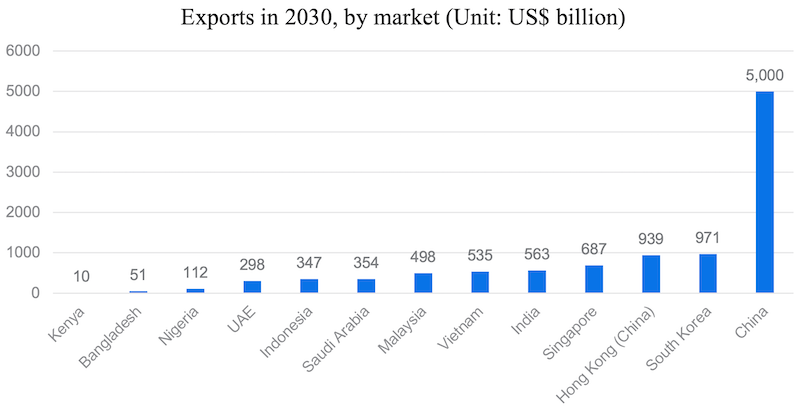Vietnam - a major driver of global trade growth by 2030
The country benefits from strengthening international integration through multiple free trade agreements.
Vietnam is a key driver of global trade growth, with its exports projected to expand at an average annual rate of more than 7% to reach US$535 billion by 2030.
| Vietnam is a major driver of global trade growth by 2030. Photo: Dinh Vu Port |
The latest research “Future of Trade 2030: Trends and markets to watch” by Standard Chartered found that 41% of global corporates currently do or plan to manufacture in Vietnam in the next five to 10 years.
“It is evident that Vietnam will be a major driver of global trade growth over the next decade,” the research underlined.
Global exports are estimated to be almost double from $17.4 trillion to $29.7 trillion over the next decade. Simon Cooper, CEO Corporate & Institutional Banking and Europe & the Americas, Standard Chartered, said: “The predicted doubling of global trade offers strong evidence that globalisation is still working, despite recent dislocation. In addition to the growth of intra-regional trade pathways, the corridors of the future will still cut across continents.”
The report reveals 13 markets that will drive much of this growth, identifies major corridors, and five trends shaping the future of global trade.
The US and Mainland China will continue to be the largest export corridors for Vietnam, accounting for 26% and 19% of total exports in 2030, respectively. India is a fast-growing export corridor for Vietnam with 11% average growth per year in the 2020-2030 period.
Future growth sectors
| Chart: Phi Nhat |
Standard Chartered said Vietnam is an emerging manufacturing powerhouse with expanding international trading relationships. The sectors which will dominate exports in 2030 including machinery & electricals, textile & apparel and agriculture & food.
Michele Wee, CEO of Standard Chartered Vietnam said Vietnam is a growing global manufacturing hub as foreign firms continue to invest in the market, incentivised by the availability of labour, geographical proximity to global supply chains, and its foreign direct investment-friendly policies.
She added the country also benefits from strengthening international integration through multiple free trade agreements (FTAs), such as EU-Vietnam FTA, UK-Vietnam FTA, the Regional Comprehensive Economic Partnership (RCEP) and the Comprehensive and Progressive Agreement for Trans-Pacific Partnership (CPTPP), allowing it to expand its exports, move up the value chain across sectors, and create skilled jobs.
“We are very positive about Vietnam’s future trade growth and committed to offering our support by leveraging our unrivalled international network and deep local knowledge,” she said.
Enabling sustainable supply chains
The research, based on economic modelling for export projections, also includes a survey of more than 500 C-suite and senior leaders in global companies.
| Chart: Phi Nhat |
Global trade will be reshaped by five key trends: the wider adoption of sustainable and fair-trade practices, a push for more inclusive participation, greater risk diversification, more digitisation and a rebalancing towards high-growth emerging markets.
Almost 90% of the corporate leaders surveyed agreed that these trends will shape the future of trade and will form part of their five to 10-year cross-border expansion strategies.
Globalisation will drive the next decade of growth. Despite the recent push towards onshoring, growth corridors of the future will not just be intraregional - they will be global spanning Africa-East Asia, ASEAN-South Asia, East Asia-Europe, East Asia- Middle East, East Asia-Europe, South Asia-US.
Asia, Africa and the Middle East will see a ramp-up in investment flows, with 82% of respondents saying they are considering new production locations in these regions in the next five to 10 years, supporting the trend towards rebalancing to emerging markets and greater risk diversification of supply chains.
The research found a significant trend towards the adoption of sustainable trade practices in response to climate concerns and a rising wave of conscious consumerism. However, while almost 90% of corporate leaders acknowledged the need to implement these practices across their supply chains, only 34% ranked it as a ‘top three’ priority for execution over the next five to 10 years.













